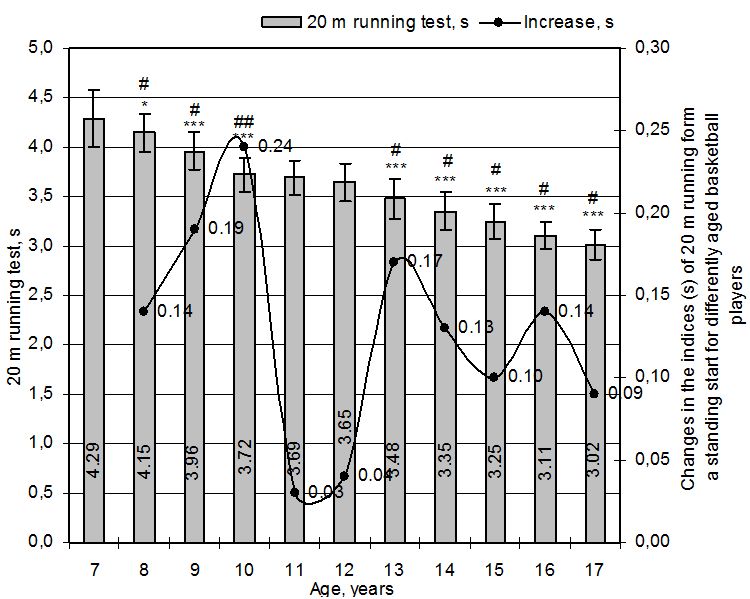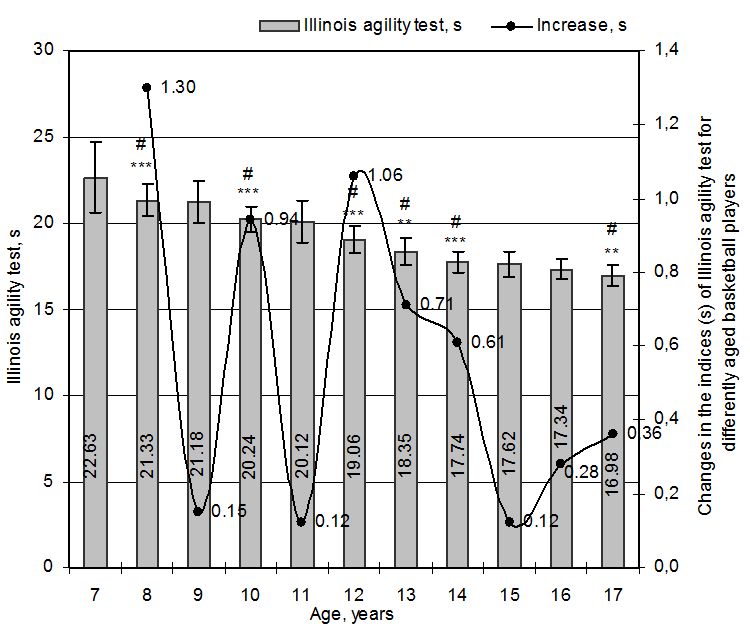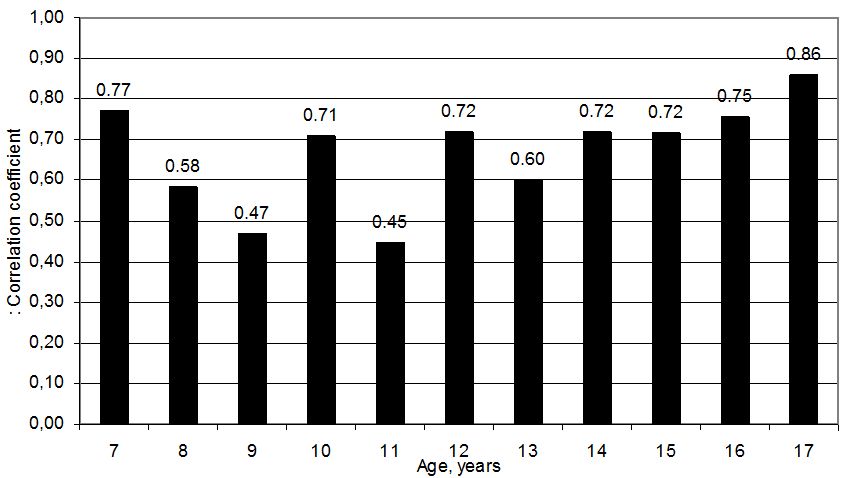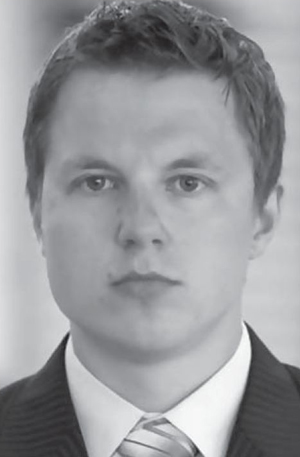STUDY OF THE PHENOMENON OF SENSITIVE PERIODS FOR OF SPEED AND AGILITY DEVELOPMENT IN YOUNG BASKETBALL PLAYERS
Фотографии:
ˑ:
Kestutis Matulaitis, doctoral candidate
Antanas Skarbalius, professor, Dr. Hab.
Key words: basketball, speed, agility, training.
Introduction. Basketball is a team sport requiring various motor skills such as speed, acceleration, sharp changes in running direction. Speed and agility have proved [2, 14, 22, 25, 34, 32] to be among the most important and required motor skills for basketball players.
Stonkus and Kuklys [33] mark that as opposed to other motor skills speed and agility are the most genetically conditioned motor skills and are hard to train, thus children and teen age is the most favorable for that. Many researches have been devoted dedicated to establishment of the best age for development of speed and agility, but there takes place a lack of research concerning the best age terms for development of speed and agility skills for junior basketball players. Thus the present study was devoted to this problem. The studies of the large sample of young basketball players (aged 7–17) are assumed to reveal the best age to develop speed and agility skills.
The best age period for development of speed and agility is still disputable. Holm [19] distinguished three best age periods to train speed and agility: the age of 12–14 for the acceleration skill, 13 - for speed with changing the running direction, and 15 for speed endurance. Viru et al. [35], Balyi, Williams [7], Stafford [30] suggest two best age periods for boys to develop speed: 7–9 and 13–16 years. According to Borms [9] speed is best developed in eight-year-old boys and 12–15-year-old teens. Malina, Bouchard, Bar-Or [26] established that the best age periods for that were 5–8 and 13-17 years. Casperson, Pereira, Curran [26] suggest that the best age for speed and agility development is 7–11 years since this index starts declining at the age of 16–17.
The purpose of the research was to establish the best age periods for development of speed and agility of young basketball players aged 7–17.
Materials and methods. Research sample included 1097 young basketball players aged 7–17 from A. Sabonis Basketball Centre. They belonged to 11 different age groups: 7 years old (n = 41), 8 years old (n = 48), 9 years old (n = 46), 10 years old (n = 94), 11 years old (n = 148), 12 years old (n = 117), 13 years old (n = 143), 14 years old (n = 206), 15 years old (n = 111), 16 years old (n = 71), 17 years old (n = 72). Anthropometric characteristics of young basketball players are given in Table 1. The research was carried out in the competition periods of 2004, 2005, 2006, and 2009. A test was applied to assess motor skills for 7–17-year-old basketball players: speed (20 m sprint from a standing start), agility (Illinois agility test).
All calculations for statistical analysis were performed using Office Excel 2003 and IBM SPSS Statistics 19 programme package. We calculated arithmetic mean, standard deviation, mean value discrepancy using Student's t test for independent samples. Assessing the statistical significance of the results, significance level of p ≤ 0.05 (95% confidence) was set. Relations between indices were established calculating Pearson’s correlation coefficients (r). We assumed that p <0.01, when r = 0.40 to 0.69; p <0.001, when r = 0.70 to 0.89 [23]. Comparing different tests in various age groups, changes in body composition indicators were assessed according to the degree of influence (ES) [13, 21]. The degree of influence was estimated based on Hopkins [20] scale (<0.2 – trivial, 0.2 to 0.6 – low, 0.6 to 1.2 – moderate, 1.2 to 2.0 – high, 2.0> very high).
Research results and discussion. Speed. The biggest changes in the indicators of speed for young 7–17-year-old basketball players (20 m running test from a high starting position) were established in the age periods of 8–9–10 years (ES = 0.60–1.00–1.33, p < 0.05) and 13–14–15–16–17 years (ES = 0.87–0.67–0.60–0.88–0.62, p < 0.001), when the degree of effect was moderate or high, compared to basketball players one year younger (Fig. 1). The evaluation of our results obtained as well as the results of other researchers showed that indices in all age groups corresponded to high or very high fitness levels [6, 32]. The mean indices of basketball players in our research sample were higher or similar to those obtained by other researchers for basketball players in different age groups: for nine-year-olds 4.30 s, 3.86 s for ten-year-olds, 11-year-olds – 3.81 s, 12-year-olds – 3.60 s, 13-year-olds – 3.46 s, 14-year-olds – 3.34 s [10], 13–14 years of age – 3.32 to 3.46 s [12], 14-year-olds - 3.27 s [1], 15-year-olds – 3.00 s [17] and 3.18 s (Santo Paulo, Maia, [28], 16-year-olds – from 3.12 [1], to 3.25 s [18], 3.22 s [15], 3.20 s [29], 3.15 s [16], 17-year-olds – 3.08 s [16], 14–17 year-olds – 3.04 s [31].

Fig. 1. Changes in the indices (s) of 20 m running form a high starting position for young basketball players. Note: * – p < 0.05; *** – p < 0.001 – statistically significant divergence compared to young basketball players one year younger, # – 0.60–1.19 – moderate; ## – 1.2–2.00 – high (level of influence – ES)
Agility. The assessment indices of agility using Illinois agility test showed that agility could be best trained at the following age periods: eight years of age (ES = 0.87, p <0.001), ten years of age (ES = 0.94, p <0.001), 12–13–14 years (ES = 1.07–0.90–0.85, p <0.001) and 17 years (ES = 0.62, p <0.01) of age for boys (Fig. 2). Illinois agility test was used very seldom by the researchers to asses agility, the indices of young basketball players aged 16-17 compared with 19-year-old basketball players (from 16.25 to 17.49 s) [5] testify to the good fitness level.

Fig. 2. Changes in the indices (s) of Illinois agility test for young basketball players. Note. ** – p < 0.01; *** – p < 0.001 – statistically significant divergence compared to basketball players one year younger, # – 0.60–1.19 – moderate (degree of influence – ES)
We also established a high correlation between speed and agility for basketball players at the age of 7, 10, and 12 and 14–17 (p < 0.001), moderate correlation at the age of 8–9, 11, 13 years (p < 0.01) (Fig. 3).

Fig. 3. Correlation between speed and agility for young basketball players according to Pearson’s correlation coefficient
Changes in the indices of children and adolescents’ speed and agility are conditioned by their individual growth and maturation [8, 12, 26, 27]. Speed and agility skills of our research sample could be as well influenced by not exactly the same training programmes applied by different coaches [3, 4, 24, 34].
Conclusion:
We established that the most sensitive age periods for development of speed and agility skills for 7-17-year-old basketball players were as follows: 8–10 and 13–17 years for speed, and 8–10, 12–14 and 17 years for agility.
We should keep in mind that children and adolescents’ biological maturity at the same age could be different, so for this reason it is recommended to train speed and agility from 7 to 17 years of age; however, speed development should receive more attention in the age periods of 8–10 and 13–17 years, and agility – 8–10, 12–14 and 17 years. Besides, it is recommended to develop speed and agility together with specific movements and actions for basketball with a ball and without it.
Bibliography
1. Zheleznyak, Y. Basketball: Training program for childrens and youth in the sports schools / Y. Zheleznyak, I. Bodinikova, B. Gaptov, B. Levin. – Moscow: Sport Committee, USSR, 1984. (In Russian)
2. Abdelkrim, B.N. Positional role and competative-level differences in elite-level men‘s basketball players. / B.N. Abdelkrim, A. Chaouachi, K. Chamari, M. Chtara, C. Castagna // Journal of Sports Strength & Conditioning Research. – 2010. – 24 (5): 1346–1355.
3. Aksen, P. The effects of combined training on some conditional parameters of basketball aged 12–14 / P. Aksen, M. Günay // Sport science, movement and health. – 2010. – 2 (10): 179–188.
4. Alarcon, F. Effect of a training program on the improvement of basketball players' decision making. / F. Alarcon, D. Cardenas, M.T. Miranda, N. Urena, M.I. Pinar, E. Torre // Revista de Psicología del Deporte. – 2009. – 18: 403–407.
5. Asadi, A. Effects of high-intensity plyometric training on dynamic balance, agility, vertical jump and sprint performance in young male basketball players / A. Asadi; H. Arazi // Journal of Sport and Health Research. – 2012. – 4 (1): 35–44.
6. Balčiūnas, M. Krepšininkų parengtumas: nustatymas ir įvertinimas / M. Balčiūnas, V. Garastas, S. Stonkus // Kaunas: LKKA, 2009.
7. Balyi, I. Coaching the young developing performer / I. Balyi, C. Williams, // Petron: HRH The Princess Royal, 2009.
8. Blanksby, B. A. Athletics, Growth, and Development in Children. / B.A. Blanksby, J. Bloomfield, T.R. Ackland, B. C. Elliott, A.R. Morton // Harwood Academic Publishers, 1994.
9. Borms, J. The Child and exercise: an overview / J. Borms // Journal of Sport Sciences. – 1986, – 4 (1): 3–20.
10. Butautas, R. (2002). Vienlaikio poveikio metodo veiksmingumas rengiant jaunuosius krepšininkus / R. Butautas // Daktaro disertacija. Kaunas: LKKA, 2002.
11. Casperson, C.J. Changes in physical activity patterns in the United States, by sex and cross-sectional age // C.J. Casperson, M.A. Pereira, K.M. Curran / Medicine & Science in Sports & Exercise. – 2000. – 32 (9): 1601–1609.
12. Coelho, E.S.M.J. Growth, maturation, functional capacities and sport-specific skills in 12-13 year-old- basketball players / E.S.M.J. Coelho, M.H. Carvalho, C.E. Goncalves, A.J. Figueiredo, M.T. Elferink-Gemser, R.M. Philippaerts, R.M. Malina // The Journal Of Sports Medicine And Physical Fitness. – 2010. – 50 (20): 174–181.
13. Cohen, J. Statistical power analysis for the behavioral sciences (2nd edn.). / J. Cohen // Hillsdale, NJ: Lawrence Erlbaum Associates, 1988.
14. Dalextrat, A. Strength, power, speed, and agility of women basketball players according to playing position / A. Dalextrat, D. Cohen // Journal of Sports Strength & Conditioning Research. – 2009. – 23 (7): 1974–1981.
15. Dežman, B. Classifying young basketball players into playing positions with chosen anthropometric and motor variables / B. Dežman, F. Erčulj, & G. Vučkovic //. In D. Milanović, (Eds.), F. Prot, (Eds). 3rd International scientific conference “Kinesiology new perspectives” (pp. 943–946). Opatija: Croatia, 2002.
16. Drinkwater E.J. Modelling age and secular differences in fitness between basketball players / E.J. Drinkwater, W.G. Hopkins, M.J. McKenna, P.H. Hunt, D.B. Pyne // Journal of Sport Sciences. – 2007. – 25 (8): 869–878.
17. Gore, Ch. J. Physiological Tests for Elite Athletes / Ch. J. Gore // Human Kinetics, 2000.
18. Hoare, D.G. Predicting success in junior elite baskethall players – the contribution of anthropométrie and physiological attributes / D.G. Hoare // Journal of Science and Medicine in Sport. – 2000. – 3 (4): 391-405.
19. Holm, J. Tennis: Play to Win the Czech Way / J. Holm // Toronto: Sport Book Publications, 1987.
20. Hopkins, W.G. A scale of magnitudes for effect statistics (2002) / W.G. Hopkins // Internet link: http://sportsci.org/resource/stats/effectmag.html. In 2010.
21. Hopkins, W.G. Spreadsheets for analysis of controlled trials, with adjustment for a subject characteristic. Sportscience. (2006) / W.G. Hopkins // Internet link: http://www.sportsci.org/ resource/stats/xPostOnlyCrossover.xls. In 2010.
22. Karpowicz, K. Interrelation of selected factors determining the effectiveness of training in young basketball players / K. Karpowicz // Human Movement. – 2006. – 7 (2): 130–146.
23. Kasiulevičius, V. Statistikos taikymas mokslinių tyrimų analizėje. / V. Kasiulevičius, G. Denapienė. // Gerontologija. – 2008. – 9 (3): 176–180.
24. Kocić, M. Influnce of training process on development of situational-motor abilities of throw precision with young basketball players / M. Kocić, D. Berić, I. Bojić // Acta Kinesiologica. – 2009. – 3 (2): 67–72.
25. Köklü, Y. Comparison of chosen physical fitness characteristics of Turkish professional basketball players by division and playing position. / Y. Köklü, U. Alemdaroğlu, F.Ü. Koçak, A.E. Erol, G. Fındıkoğlu // Journal of Human Kinetics – 2011. – 30: 99–106.
26. Malina, R.M., Growth, Maturation, and Physical Activity / R.M. Malina, C. Bouchard, O. Bar-Or // Human Kinetics, 2004.
27. Malina, R.M. Sex Differences in Growth and Performance of Track and Field Athletes 11–15 Years. / R.M. Malina, T. Sławinska, Z. Ignasiak, K. Rożek, K. Kochan, J. Domaradzki, J. Fugiel // Journal of Human Kinetics. – 2010. – 24: 79–85.
28. Santo, E. Effects of specific training and detraining in explosive strength: A study on young male basketball players. / E. Santo, A.M. Janeira, J.A. Maia // Revista Paulista de Educacao Fisica. – 1997. – 11(2), 116–127.
29. Skernevičius, J. Sporto mokslo tyrimų metodologija / J. Skernevičius, A. Raslanas, R. Dėdelienė // Vilnius: Lietuvos sporto informacijos centras, 2004.
30. Stafford, I. Coaching for long-term athlete development: to improve participation and performance in sport / I. Stafford // Petron: HRH The Princess Royal, 2010.
31. Stapff, A. Protocols for the physiological assessment of basketbal players. In: C. Gore (Eds.). Physiologieal tests for elite athletes / A. Stapff // Human Kinetics, 2000.
32. Stonkus, S. Krepšinis / S. Stonkus // Kaunas: LKKA, 2003.
33. Stonkus S. Parengiamieji krepšinio žaidimai / S. Stonkus, V. Kuklys // Vilnius: LSIC, 2001.
34. Trinic, S. Effects of development training of basketball cadets realised in the competitive period / S. Trinic, G. Markovic, S. Heimer // Collegium Antropologicum. – 2001. – 25 (2): 591–604.
35. Viru, A. Age periods of accelerated improvements of muscle strength, power, speed and endurance in age interval 6–18 years / A. Viru, J. Loko, A. Volver, L. Laaneots, K. Karlesom, M. Viru // Biology of Sport. – 1998. – 15 (4): 211–227.
Author’s contacts: k.matulaitis@lkka.lt



 Журнал "THEORY AND PRACTICE
Журнал "THEORY AND PRACTICE